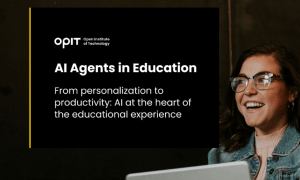

The journey towards building ethical AI is challenging, yet it also presents an opportunity to shape a future where technology serves as a force for good
By Riccardo Ocleppo, March 14th 2024
Source here:eCampus News
In the exponentially-evolving realm of artificial intelligence (AI), concerns surrounding AI bias have risen to the forefront, demanding a collective effort towards fostering ethical AI practices. This necessitates understanding the multifaceted causes and potential ramifications of AI bias, exploring actionable solutions, and acknowledging the key role of higher education institutions in this endeavor.
Unveiling the roots of AI bias
AI bias is the inherent, often systemic, unfairness embedded within AI algorithms. These biases can stem from various sources, with data used to train AI models often acting as the primary culprit. If this data reflects inequalities or societal prejudices, it can unintentionally translate into skewed algorithms perpetuating those biases. But bias can also work the other way around: take the recent case of bias by Google Gemini, where the generative AI created by Google, biased by the necessity of more inclusiveness, actually generated responses and images that have nothing to do with the reality it was prompted to depict.
Furthermore, the complexity of AI models, frequently characterized by intricate algorithms and opaque decision-making processes, compounds the issue. The very nature of these models makes pinpointing and rectifying embedded biases a significant challenge.
Mitigating the impact: Actionable data practices
Actionable data practices are essential to address these complexities. Ensuring diversity and representativeness within training datasets is a crucial first step. This involves actively seeking data encompassing a broad spectrum of demographics, cultures, and perspectives, ensuring the AI model doesn’t simply replicate existing biases.
In conjunction with diversifying data, rigorous testing across different demographic groups is vital. Evaluating the AI model’s performance across various scenarios unveils potential biases that might otherwise remain hidden. Additionally, fostering transparency in AI algorithms and their decision-making processes is crucial. By allowing for scrutiny and accountability, transparency empowers stakeholders to assess whether the AI functions unbiasedly.
The ongoing journey of building ethical AI
Developing ethical AI is not a one-time fix; it requires continuous vigilance and adaptation. This ongoing journey necessitates several key steps:
- Establishing ethical guidelines: Organizations must clearly define ethical standards for AI development and use, reflecting fundamental values such as fairness, accountability, and transparency. These guidelines serve as a roadmap, ensuring AI projects align with ethical principles.
- Creating multidisciplinary teams: Incorporating diverse perspectives into AI development is crucial. Teams of technologists, ethicists, sociologists, and individuals representing potentially impacted communities can anticipate and mitigate biases through broader perspectives.
- Fostering an ethical culture: Beyond establishing guidelines and assembling diverse teams, cultivating an organizational culture prioritizes ethical considerations in all AI projects is essential. Embedding ethical principles into an organization’s core values and everyday practices ensures ethical considerations are woven into the very fabric of AI development.
The consequences of unchecked bias
Ignoring the potential pitfalls of AI bias can lead to unintended and often profound consequences, impacting various aspects of our lives. From reinforcing social inequalities to eroding trust in AI systems, unchecked bias can foster widespread skepticism and resistance toward technological advancements.
Moreover, biased AI can inadvertently influence decision-making in critical areas such as healthcare, employment, and law enforcement. Imagine biased algorithms used in loan applications unfairly disadvantaging certain demographics or in facial recognition software incorrectly identifying individuals, potentially leading to unjust detentions. These are just a few examples of how unchecked AI bias can perpetuate inequalities and create disparities.
The role of higher education in fostering change
Higher education institutions have a pivotal role to play in addressing AI bias and fostering the development of ethical AI practices:
- Integrating ethics into curricula: By integrating ethics modules into AI and computer science curricula, universities can equip future generations of technologists with the necessary tools and frameworks to identify, understand, and combat AI bias. This empowers them to develop and deploy AI responsibly, ensuring their creations are fair and inclusive.
- Leading by example: Beyond educating future generations, universities can also lead by example through their own research initiatives. Research institutions are uniquely positioned to delve into the complex challenges of AI bias, developing innovative solutions for bias detection and mitigation. Their research can inform and guide broader efforts towards building ethical AI.
- Fostering interdisciplinary collaboration: The multifaceted nature of AI bias necessitates a collaborative approach. Universities can convene experts from various fields, including computer scientists, ethicists, legal scholars, and social scientists, to tackle the challenges of AI bias from diverse perspectives. This collaborative spirit can foster innovative and comprehensive solutions.
- Facilitating public discourse: Universities, as centers of knowledge and critical thinking, can serve as forums for public discourse on ethical AI. They can facilitate conversations between technologists, policymakers, and the broader community through dialogues, workshops, and conferences. This public engagement is crucial for raising awareness, fostering understanding, and promoting responsible development and deployment of AI.
Several universities and higher education institutions, wallowing in the above principles, have created technical degrees in artificial intelligence shaping the artificial intelligence professionals of tomorrow by combining advanced technical skills in AI areas such as machine learning, computer vision, and natural language processing while developing in each one of them ethical and human-centered implications.
Also, we are seeing prominent universities throughout the globe (more notably, Yale and Oxford) creating research departments on AI and ethics.
Conclusion
The journey towards building ethical AI is challenging, yet it also presents an opportunity to shape a future where technology serves as a force for good. By acknowledging the complex causes of AI bias, adopting actionable data practices, and committing to the ongoing effort of building ethical AI, we can mitigate the unintended consequences of biased algorithms. With their rich reservoir of knowledge and expertise, higher education institutions are at the forefront of this vital endeavor, paving the way for a more just and equitable digital age.
Related posts

Source:
- Times of Malta, published on September 18th, 2025
4 min read
The gathering brought together academics and technology leaders from prominent European Institutions, such as Instituto de Empresa (IE University), OPIT itself and the Royal College of Arts, to explore how artificial intelligence is reshaping the university experience.
The OPIT AI Copilot has been trained on the institute’s complete academic archive, a collection created over the past three years that includes 131 courses, more than 3,500 hours of recorded lectures, 7,500 study resources, 320 certified assessments, and thousands of exercises and original learning documents.
Unlike generic AI tools, the Copilot is deeply integrated with OPIT’s learning management system, allowing it to track each student’s progress and provide tailored support.
This integration means the assistant can reference relevant sources within the learning environment, adapt to the student’s stage of study, and ensure that unreleased course content remains inaccessible.
A mobile app is also scheduled for release this autumn, that will allow students to download exercise and access other tools.
During examinations, the Copilot automatically switches to what the institute calls an “anti-cheating mode”, restricting itself to general research support rather than providing direct answers.
For OPIT’s international community of 500 students from nearly 100 countries, many of whom balance studies with full-time work, the ability to access personalised assistance at any time of day is a key advantage.
“Eighty-five per cent of students are already using large language models in some way to study,” said OPIT founder and director Riccardo Ocleppo. “We wanted to go further by creating a solution tailored to our own community, reflecting the real experiences of remote learners and working professionals.”
Tool aims to cut correction time by 30%
The Copilot will also reduce administrative burdens for faculty. It can help grade assignments, generate new educational materials, and create rubrics that allow teachers to cut correction time by as much as 30 per cent.
According to OPIT, this will free up staff to dedicate more time to teaching and direct student engagement.
At the Milan event, Rector Francesco Profumo underlined the broader implications of AI in higher education. “We are in the midst of a deep transformation, where AI is no longer just a tool: it is an environment that radically changes how we learn, teach, and create,” he said.
“But it is not a shortcut. It is a cultural, ethical, and pedagogical challenge, and to meet it we must have the courage to rethink traditional models and build bridges between human and artificial intelligence.”
OPIT was joined on stage by representatives from other leading institutions, including Danielle Barrios O’Neill of the Royal College of Art, who spoke about the role of AI in art and creativity, and Francisco Machin of IE University, who discussed applications in business and management education.
OPIT student Asya Mantovani, also employed at a leading technology and consulting firm in Italy, gave a first-hand account of balancing professional life with online study.
The assistant has been in development for the past eight months, involving a team of OPIT professors, researchers, and engineers.
Ocleppo stressed that OPIT intends to make its AI innovations available beyond its own institution. “We want to put technology at the service of higher education,” he said.
“Our goal is to develop solutions not only for our own students, but also to share with global institutions eager to innovate the learning experience in a future that is approaching very quickly.”

From personalization to productivity: AI at the heart of the educational experience.
Click this link to read and download the e-book.
At its core, teaching is a simple endeavour. The experienced and learned pass on their knowledge and wisdom to new generations. Nothing has changed in that regard. What has changed is how new technologies emerge to facilitate that passing on of knowledge. The printing press, computers, the internet – all have transformed how educators teach and how students learn.
Artificial intelligence (AI) is the next game-changer in the educational space.
Specifically, AI agents have emerged as tools that utilize all of AI’s core strengths, such as data gathering and analysis, pattern identification, and information condensing. Those strengths have been refined, first into simple chatbots capable of providing answers, and now into agents capable of adapting how they learn and adjusting to the environment in which they’re placed. This adaptability, in particular, makes AI agents vital in the educational realm.
The reasons why are simple. AI agents can collect, analyse, and condense massive amounts of educational material across multiple subject areas. More importantly, they can deliver that information to students while observing how the students engage with the material presented. Those observations open the door for tweaks. An AI agent learns alongside their student. Only, the agent’s learning focuses on how it can adapt its delivery to account for a student’s strengths, weaknesses, interests, and existing knowledge.
Think of an AI agent like having a tutor – one who eschews set lesson plans in favour of an adaptive approach designed and tweaked constantly for each specific student.
In this eBook, the Open Institute of Technology (OPIT) will take you on a journey through the world of AI agents as they pertain to education. You will learn what these agents are, how they work, and what they’re capable of achieving in the educational sector. We also explore best practices and key approaches, focusing on how educators can use AI agents to the benefit of their students. Finally, we will discuss other AI tools that both complement and enhance an AI agent’s capabilities, ensuring you deliver the best possible educational experience to your students.
Have questions?
Visit our FAQ page or get in touch with us!
Write us at +39 335 576 0263
Get in touch at hello@opit.com
Talk to one of our Study Advisors
We are international
We can speak in:
